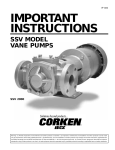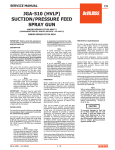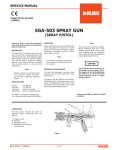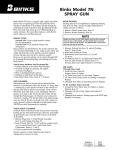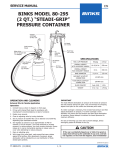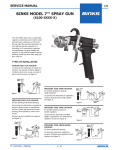Transcript
HOW DOES YOUR SPRAY GUN SHAPE UP? No matter how experienced the sprayer, merely triggering and moving a gun in space will not reveal any of the performance characteristics vital to a top quality finish. A simple brief static spray pattern will immediately highlight any potential problems before the gun is used on the painstakingly prepared workpiece or vehicle. Follow the procedure explained below and compare the pattern to our examples. If your result resembles examples 2-8 then look at the corrective measures before you apply paint to the workpiece. 1. Ensure that you have the correct air cap, fluid tip and needle set-up on the gun to match the material being applied. 2. Tape up a piece of brown paper—approx. 20" (1/2 m) square—onto the spray booth wall at shoulder height. 3. Having set the gun at the recommended inlet or atomizing air pressure, hold it at the correct target distance and spray at the paper WITHOUT MOVING THE GUN. Normal Pattern – Ready to Spray Intermittent Spray Fan or Fluttering • Air in the fluid passageways • Insufficient paint in cup • Fluid tip loose • Fluid needle packing or packing screw loose • Cup vent hole clogged • Good balance and uniformity • Symmetrical pattern shape • Good working height and width • Uniform distribution of material (Verify by horizontal spray out) Banana Pattern Heavy Top or Bottom Pattern • Air cap horn hole dirty or damaged • Test spray pattern, rotate 180° and test again to isolate horn hole location • Clean air cap thoroughly • Replace air cap if necessary • Fluid tip or air cap dirty or damaged • Test spray pattern, rotate 180° and test again to isolate cause • Clean both items thoroughly • Replace fluid tip or air cap if necessary Single Split Pattern Center Heavy Ellipse • Bad air or paint setting • Viscosity too high – thin with solvents • Fluid flow too high – reduce • Air pressure too low – increase • Too much air for fluid quantity used • Reduce air pressure at regulator • Increase fluid flow by changing fluid tip size or opening needle control knob Double Split Pattern Ball End Heavy Pattern • Too much air flow • Change fluid tip for smaller size • Reduce flow using fluid needle control • Reduce fan size using fan control • Too much air for fluid quantity used • Reduce air pressure at regulator • Increase fluid flow by changing fluid tip size or opening needle control knob STATIC PATTERN TEST Having examined the vertical spray pattern for uniformity of shape and size, now turn the air cap through 90° and static spray a horizontal pattern making sure you trigger for long enough to load the shape with material. Then watch to see the formation of the run-outs of material across the full width of the sprayed pattern. This will highlight how well the material is distributed throughout the spray pattern. If run-out is more obvious at the center or at the ends then this indicates a problem. TYPICAL GOOD PATTERN RUN-OUT TYPICAL BAD PATTERN RUN-OUT THE THREE “C”s OF SPRAY GUN TROUBLESHOOTING — CONDITION, CAUSE, CORRECTION The information below provides you with a simple and effective method of tracing problems with your gun if it proves troublesome. Look down the left hand “CONDTITION” column until you identify the problem and you will find the possible “CAUSE” and “CORRECTION” that needs to be taken. A A CONDITION CAUSE CORRECTION Will not spray No air pressure at gun Fluid needle adjusting screw not open enough Fluid too heavy for suction feed Check air supply and air lines Change to proper suction feed air cap Increase fluid pressure at tank Open fluid needle adjusting screw Thin material or change to pressure feed Gun spits paint when triggering on and off Incorrect needle fitted to gun Excessive needle wear Excessive fluid tip wear Small air leak from air cap when gun is not triggered Air valve contaminated and not correctly sealing Remove valve and thoroughly clean valves shaft and seating A Gun spits paint when triggering on due to paint build-up inside air cap between spraying operations Fluid tip not fitted correctly in gun head Tighten to correct torque Fluid tip/needle leakage Check for damage or blockage Slow fluid leak from fluid tip and needle seat Fluid tip internal seat scored, damaged or worn Fluid needle external profile damaged or worn Contamination on needle or tip mating surfaces preventing good seal Incorrect fluid tip for fluid needle fitted to gun Sluggish needle Tight packing B Major fluid leak or fluid jetting from fluid tip Contamination on needle or tip mating tip and needle seat Incorrect fluid tip for fluid needle fitted to gun Fluid needle stuck or “binding up” B Paint build-up on fluid tip Fluid tip not fitted correctly in gun head Fluid tip/needle packing worn or loose w w w. d e v i l b i s s . c o m K G E Check tip/needle selection chart and fit correct item Remove needle and clean or lubricate packing Adjust Remove tip and needle and thoroughly clean surfaces preventing good seal Check tip/needle selection chart and fit correct item Remove and clean fluid needle shaft Lubricate needle packing Loosen needle packing F B Tighten to correct torque Check for damage or blockage J Replace K Paint build-up on air cap Damaged air cap holes Gradual build-up of bounce-back on gun head Replace with new air cap Thoroughly clean G Air cap retaining ring will not rotate Contamination on retaining threads Deformed or damaged retaining ring Soak gun head in solvent to soften paint Cut retaining ring off of gun (probably replace retaining ring and baffle as well) E Stiff trigger action Air valve stem bent Contamination on air valve stem Contamination on trigger bearing screw Contamination on fluid needle shaft Fluid needle packing too tight Replace damaged component Remove and clean Remove and clean Remove and clean Loosen packing nut H Unable to turn fan control knob on top rear of gun Internal o-ring swollen or broken Paint contamination on threads Unable to get round spray Fluid tip or air baffle incorrectly fitted H C Unable to turn air control valve on handle of gun Internal o-ring swollen or broken Paint contamination on threads Replace o-ring Remove and thoroughly clean D Air valve sluggish or slow to turn on/off when trigger is pulled/released Air valve stem bent Replace damaged component D D Air leak from around air valve stem Air valve will not operate (air valve stem will not fully slide into valve body) when trigger is pulled Contamination on air valve stem Air valve seal damaged or missing Air valve stem bent Contamination on air valve stem Remove and clean Replace Remove air valve and replace damaged air valve stem Remove air valve and thoroughly clean I Air leak from baffle seal Baffle seal swollen or damaged Replace C Slow fluid leak from needle packing Fluid needle packing worn or loose Tighten or replace as necessary DeVilbiss has over 100 years of experience and innovation and offers some of the finest HVLP and conventional spray guns, tanks, cups and accessories in the finishing industry. Industrial Finishing | DeVilbiss 195 Internationale Blvd., Glendale Heights, IL 60139 | For Your Nearest Distributor Call: 1-888-992-4657 Air baffle chimney damaged Replace o-rings Remove and thoroughly clean Remove, check components for damage and refit correctly Replace air baffle J D I CORRECTION Air leak from fluid needle exit point in top of handle Seal damaged or missing H Replace Replace Thoroughly clean CAUSE F A Check tip/needle selection chart and fit correct item Replace with new needle Replace with new fluid tip A B CONDITION TH1POSTER (6/07)
